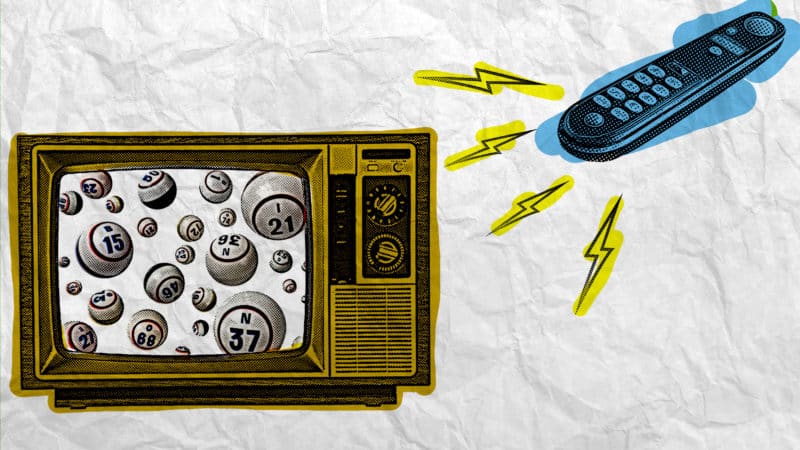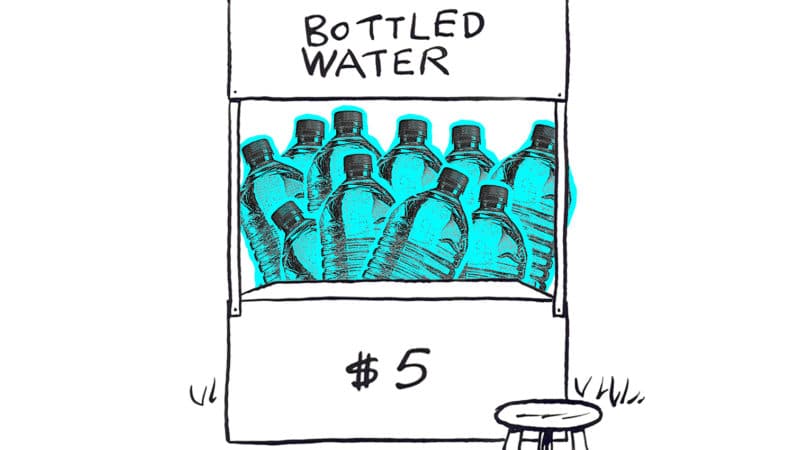Temperatures in South Florida can drop below 40 degrees. Without shelter, the elements are harmful and potentially deadly — even here.
By Joe Pye
Mary Stewart was sleeping in a tent in the woods for two years by the time she first caught pneumonia.
She coughed up phlegm and mucus non-stop into napkins and toilet paper from a local McDonald’s. An entire week went by where she laid bundled in a coat, burning up from a fever while shivering from body chills, having no energy to eat or go out and panhandle.
After seven days, her hunger grew too painful to rest any longer, so she pulled herself together and left the tent she called home in search of a can of soup from a nearby Winn Dixie. Up until then, Stewart says she survived solely on water and other liquids. The next day, she took an hour-long bus ride to the emergency room in JFK Medical Center in Lake Worth.
“[The nurses] had to put me on oxygen and rush me in for a chest x-ray,” says Stewart, who’s also written for the Homeless Voice. “They said I had pneumonia on my left lung and admitted me for an entire week.”
That was the middle of January in Palm Beach, Florida. Fourteen years — and one more bout of pneumonia — later, and Stewart still sleeps in a tent outside, chronically homeless since 2005. And her story is common to hear for homeless healthcare providers throughout the country.
Wintertime health risks for the homeless
For those who are unsheltered — meaning living somewhere not fit for human habitation such as the street, an abandoned building etc. — the winter season can bring life-threatening health risks according to Dr. Courtney Pladsen.
Pladsen is the director of clinical and quality improvement at the National Health Care Council for the Homeless (NHCHC), a nonprofit organization that works with more than 300 clinics across the country training and sharing research, including in Portland, Maine where she is based.
The effects of cold weather on people experiencing homelessness are “all too familiar,” to her, she says.
One issue many patients come to her with is a condition called “trench foot,” where they step in snow and can’t dry off as they have nowhere warm and dry to go to. They can develop painful blisters that make it difficult to walk and can lead to infection.
Another risk is from the cold alone. “I’ve had patients who have had amputations because of frostbite,” Pladsen says, “and lots who’ve had nerve damage.”
But the biggest health risk is hypothermia.
Hypothermia is when body temperature falls below 95 F, a “severe medical emergency,” according to the NHCHC. The heart, brain, and kidneys can malfunction, and lead to death.
“Malnutrition, decreased body fat, underlying infection, lack of fitness, fatigue, inadequate shelter and heat,” are all risk factors for developing hypothermia as well, and all common in those experiencing unsheltered homelessness.
According to the National Coalition for Homelessness’ 2010 report “Bringing Our Neighbors in from the Cold,” relatively few people die directly from hypothermia, but rather complications that come from it. The report highlights how, “even those who seek shelter – and are allowed to enter – are frequently turned back onto the streets during the day,” leaving them to bear the cold once again.
“700 people experiencing or at risk of homelessness are killed from hypothermia annually in the United States,” the same report estimates. This is because the risk of hypothermia is not solely tied to outdoor ambient temperature, but also wind-chill, amount of clothing to protect, and whether that clothing is even dry.
Many people experiencing homelessness are also experiencing alcohol and substance abuse dependency. Alcohol, nicotine, street drugs, and some medication all increase the risk of developing hypothermia, according to the NHCHC.
This is something Stewart has experienced and was surprised about. Throughout the 16 years she’s been on and off the streets, friends of hers have died due to alcohol and drug dependency.
“I didn’t even know that,” she says. “I’ve known a lot of people who would drink whiskey when it’s 45 degrees out. Imagine people in New York or New Jersey.”
In Pladsen’s experience, northern cities are rarely prepared to handle the amount of people who need shelter in the winter months. Most cities nationwide, she says, lack cold-weather response plans. To make matters worse, the COVID-19 pandemic has lessened volunteers, closed shelters, and lowered the amount of beds available, generally amplifying challenges for homeless service providers and the communities they assist.
An “unprecedented winter”
Before the pandemic, emergency shelter beds for cold weather were already too few for the amount of individuals experiencing unsheltered homelessness — 192,793 too few. According to that same 2010 report, out of a sample of 50 emergency winter shelters across the country, only 20 opened above 32 F, the rest opened either when it dropped even farther, or to the shelter’s own discretion at the time.
This leads to the possibilities of these health risks Pladsen was weary of, as those needing the shelter are forced back outside during the day again — if they had found a bed to begin with.
Last year, cities had specific funding called ESG-CV funding, an Emergency Solutions Grant through the CARES Act. Cities could use ESG-CV funding for hotels and motels to decompress shelters and house people during these cold months.
But this year, many cities and municipalities have run out of that money.
Shelters that were overburdened prior to the pandemic have been cut to half capacity, making it that much tougher to find beds to sleep during winter months. Many soup kitchens throughout the country have closed as well due to the pandemic and there are fewer volunteers to help, according to Pladsen.
The United States Department of Housing and Urban Development (HUD) tracks the number of “sheltered and unsheltered people experiencing homelessness on a single night,” called a “Point-in-Time Count.” That single night is in January and the count is repeated annually.
The last count was in January 2020, just before the pandemic began, and Pladsen points out, the first time since the count began in 2007 that unsheltered individuals outnumbered sheltered ones. “So more people are opting to sleep outdoors than in shelters,” she says. “And that was before the pandemic.”
All signs suggest that this season will be more severe with what Pladsen calls, “a winter with unprecedented challenges.”
“Programs that were online last year for winter in many places are now closed with nothing else new coming online,” she says. “They’ve closed hotels and motels and that funding is over. Shelters are not opening more beds and there are no new ones being built. So it has created a particular challenge this year from last year.”
Florida and the unhoused: little shelter, little health care
Florida is a non-Medicaid expansion state under the Affordable Care Act, and that makes for a disproportionate rate of uninsured residents in the state, says Pladsen. This is because, according to the Florida Medicaid Benefits site, only those who are pregnant, responsible for a child, living with a disability or have family members with a disability, or are 65 years of age and older qualify. Without some form of health insurance, there’s a barrier for physical and mental health care, she says.
Stewart, being diagnosed with high-functioning autism and bipolar disorder, is eligible for Medicaid in the state of Florida, but not everyone going through the homeless experience has similar resources.
Pladsen recalls a patient who fled the cold in Portland only to find fewer resources in South Florida.
“He heard it might be easier to get away from the bad weather,” she says. “He found out he couldn’t find any shelter or health care the entire six months he was there. So he just ended up coming back to Maine. We hear that people can’t find services and get out of homelessness a lot in Florida.”
Eligibility for services in Florida doesn’t necessarily mean being taken seriously for those issues though.
Stewart’s hour-long bus ride to Lake Worth wasn’t her first attempt to treat her pneumonia. She had visited a hospital run by her caseworker, located within walking distance of her camp. The caseworker didn’t believe she was sick and wanted to admit her into a psychiatric ward instead, Stewart says.
“I was curled up in a ball crying in the waiting room,” Stewart says. “The doctor told me he’s been sick before and never acted like that.”
In response, she hopped on the Palm Tran, the local public transportation bus system. A hospital located only 11 miles and 17 minutes away by car took one hour and two buses to get to.
Stewart has also experienced homelessness in Kentucky and North Carolina. She’s stayed in homeless shelters everywhere she’s experienced homelessness, except for Florida. The nearby shelters to her like the Lewis Center aren’t welcoming in her experience.
In Louisville, Kentucky, she says you can’t walk more than three blocks without finding another place offering meals to the homeless.
She theorizes Florida’s lack of services has a lot to do with the tourism driven economy in the state.
“They have all of these tourists coming down and don’t want eyesores in the community,” Stewart says. “So they refuse to help the homeless to try and deter them from being here because they don’t want their tourism dollars affected. In other states there actually is more help for the homeless.”
Others living through the homeless experience in Florida have similar criticisms and tell the Homeless Voice the same. One Broward County man said the last time he stayed at a shelter it was infested with bed bugs. So now he opts to sleep in his car.
How the unhoused can prepare for the winter
Stewart has learned more than a few lessons since the last time she was diagnosed with pneumonia. She’s since been vaccinated for pneumonia, COVID-19 and the flu.
As someone who’s experienced homelessness on and off for 16 years, she advises to never keep wet clothing or blankets, but acknowledges that’s tough to do in a rainy climate.
Palm Beach State College offers a homeless exemption program, in which Stewart has enrolled and already graduated with an associates degree. That gives her the ability to also qualify for low-income student resources on campus like Panther’s closet, a thrift store where all items are only one dollar for students. She’s able to purchase winter clothing like sweaters, long pants and long sleeve shirts there.
Years ago, Stewart was assigned a lawyer because she had to give her children up for adoption. She and the lawyer stay in touch and on occasion she receives meals, blankets and other gifts from her.
But these problems are bigger than a few blankets and dry clothes.
Pladsen recommends cities look into winter planning resources from organizations like HUD. To her, the major issue noticed by the unhoused sources in this story is how shelters attempt to operate on their own. There needs to be a healthcare provider partnered with the shelters, she says.
States, cities and municipalities do have what’s called Continuums of Care: a program that helps fund shelter systems and federally-supported housing, among other efforts like organizing the point-in-time count.
Pladsen uses Sulzbacher in Jacksonville, Florida as an example for what shelters in South Florida should model themselves after. Sulzbacher was founded in 1995 with the mission that, “homeless persons need and deserve more than just a meal and a bed to end their homelessness.”
Sulzbacher took the Continuum of Care approach to use funding for three entities: housing, income, and healthcare.
Pladsen says to better serve communities, Continuum of Cares must bring together the intersection of health and housing to help people get out of the cycle of homelessness.
“We’re not going to address this complex challenge with one single solution,” Pladsen says. “We really need all hands on deck to acknowledge this isn’t working.”



